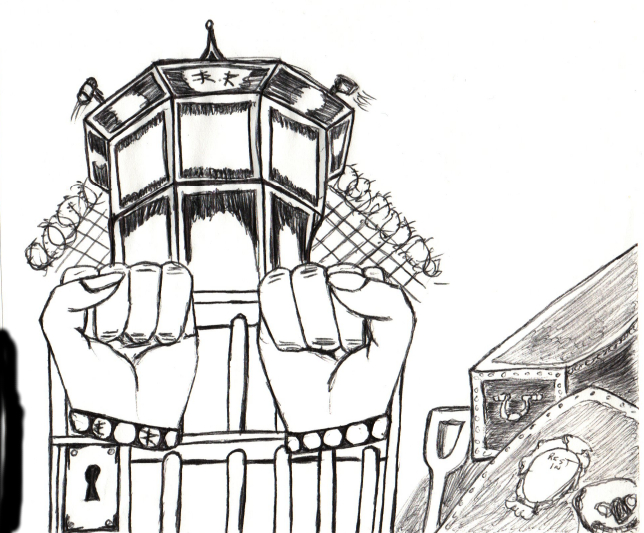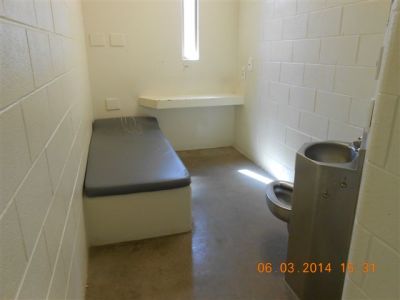I’ve been in solitary confinement here at Louisiana’s Prison for 2 years
now. David Wade Correctional Institution is a DOC facility. A
disciplinary, concentration camp. Louisiana’s most repressive prison.
Everywhere you move you have to be shackled and handcuffed. Even to the
shower if it’s a few feet from your cell. You use the phone once a
month, for 10 minutes. Our yard time is only 5 days out the week for 1
hour, inside of a chicken wired cage almost the same size as your cell.
The prison is designed to break the mind, body and soul.
Incarcerated individuals here are living in inhumanity in its purest
form. I met some guys who have been here on extended lockdown (solitary
confinement) for six, seven, eight years straight. Our superiors are
antagonists that despise the strong. Their job is to introduce us to the
elements of repression. Their goal is to break you… by any means
necessary.
It’s the heart of the summer and it gets really hot on these cell
blocks. We’re the only prison in the state of Louisiana that only has
one fan on each tier. Its nearly 100 degrees! On top of that, there’s no
water and we’re not allowed ice on the tier. The only water that we’re
allowed to drink is out of our sink. And sometimes our pipes are backed
up, or there’s a boil-water warning on the news. If we want water, our
only option is to drink contaminated water out our sinks, which is cruel
and unusual punishment. Inhumanity. Not to mention that we’re only
allowed books and newspapers. We have no access to any television or
radio. The papers is how we find out about the boil water warnings, and
sometimes the newspapers come too late because of slow mail.
They want you to put your jump suit all the way on, while you’re in your
cell all during the day while it’s nearly 100 degrees. This is
only a tactic to make you as uncomfortable as possible. You see, every
day in these cells is war. They take you to war every single day.
Psychological warfare.
A lot of the guys here can’t endure the delinquency of the officers, nor
could they endure these extreme circumstances of dehumanization. I watch
guys break right before my eyes all the time. The mind is very elusive…
Hold it tight. One minute you’ll be talking to a guy and the next minute
they just snap, right before your very eyes, as if their mind was an egg
that slipped out of their hand, and splattered across the hard rough
pavement.
These situations are so frequent that a lot of the individuals here have
gotten used to it. They have so adjusted to where they believe that
these abnormal situations are normal. Just a couple of weeks ago a guy
hung himself in his cell. His body dangled for a couple of hours before
anyone even noticed. He was then rolled off the tier, and it was as if
nothing had happen.
Guys use to be killed here by guards all the time. That was until word
started to leak outside of these walls and into the free world. But that
still wasn’t enough to mentally liberate us. We need outside help…
recognition… the voice of society… we need revolution!
I’m fortunate enough to be one of the few to be spiritually emancipated.
Subsequently I have become a revolutionist. The change has already
begun. And unity is a very fundamental principle.
We’re dying to live….but we’re living to die.
There’s about 11 of us total who have been on hunger strike. Today makes
my 4 1/2 day without food [11 July 2016]. About 8 or 9 other guys have
reached their 7 day mark. But this is only the beginning. We would
probably have to go a couple of weeks on hunger strike for them to even
take us seriously, which is hard work without the outside help, or
support. Also the oppressor refuses to stand down without opposition.
Their tactics are vital. You could be on hunger strike for 4 or 5 days
and they wouldn’t even document it. That way they won’t have to report
so many to D.O.C headquarters. But also subsequently you wouldn’t
receive mandatory medical treatment, which is protocol after a prisoner
misses 9 meals.
You’re declared to be suicidal. By refusing to follow their protocol
they violate our constitutional rights. But we’re willing to go however
long it takes. We also have multiple comrades who have made it to the
courts system to push even further after they have successfully
exhausted the grievance process. Our fundamental goal is for change…
Better circumstances. We want the same thing that the “Pledge of
Allegiance” taught us. We want Liberty and Justice for all.
MIM(Prisons) responds: We stand with this writer and the comrades
in Louisiana fighting back against the dangerous and inhumane conditions
at David Wade Correctional Center. This comrade is right that actions
behind bars need outside support. It is also important to have some
clear demands when we undertake big protests like a hunger strike. This
will help focus the response, and ensure that we know when we have won.
Fighting for general liberty and justice is definitely our goal as
communists, but we know we will never achieve that under capitalism, and
so our actions should be focused on winnable battles today while we
build for liberation for all through revolution.










